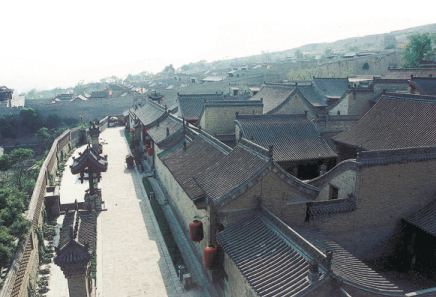Local 'Forbidden City' leaves an impression
Updated: 2021-04-30

As the largest ancient civilian residence complex in China, the Grand Courtyard of the Wang Family in Lingshi county is called by many the "Forbidden City in Shanxi". [Photo by Peng Ke'er/China Daily]
A visit to the Grand Courtyard of the Wang Family in Lingshi county in central Shanxi is an experience that makes people believe it's no exaggeration to call this renowned attraction the "Forbidden City in Shanxi".
Located in the town of Jingsheng, the grand courtyard is only 35 kilometers to the southwest of the ancient city of Pingyao and 150 km from the Shanxi provincial capital of Taiyuan.
It was built by the Wang family during Emperor Kangxi's reign (1661-1722) and Emperor Jiaqing's reign (1796-1820) in the Qing Dynasty (1644-1911). The site features the typical architectural style of the Qing Dynasty.
The huge residential complex covers 250,000 square meters and consists of five alleys, five castles, five ancestral halls, 123 small courtyards and 2,078 rooms. The number of rooms and courtyards is so big that no other civilian residence in China can match them.
Another similarity it shares with the Forbidden City is the layout of the yards shows the strict hierarchical system of ancient China. Rooms and yards with different scales were offered to people in accordance with their social status.
And the entire complex is protected by a long and tall city wall like that of the Forbidden City.
The residential complex is the glory of the Wang family, which has been ranked among the top four prestigious families in Lingshi, and the brilliant history of the renowned Jinshang merchants.
Shanxi is known for its historical commerce that was developed by the local merchants, or Jinshang. It is said that Jinshang merchants dominated commercial circles in North China for about 500 years starting from the Ming Dynasty (1368-1644).
Many of these successful merchants began as small vendors and made a fortune through hard work over generations.
The family history book shows that the Wang family has been in Lingshi for more than 700 years. Like many Jinshang merchants, the early ancestors began their business by selling bean curd and later made a fortune that lasted for several centuries.
After their success in business, the family's members began to enter the political circle in the early Qing Dynasty, with more than 40 family members serving as officials in the imperial court. The combination of business and politics further added to the prosperity of the family, so the members launched massive construction projects and built their own mansions for about 200 years.
Because the residential complex is so large, there are too many things for visitors to explore.
To make a tour both efficient and impressive, the three sites-the Shilyu Castle, the Red Gate Castle and the Gaojiaya Building Complex-are the most extraordinary highlights for visitors.
There are rich and exquisite carvings on the walls, in themes including flowers, birds, animals, fish, insects and storied tales. The carvings are wide in variety and superb in skill. A lot of excellent artists, craftsmen and painters of the times worked together to accomplish such grand works. Family instructions, as well as the teachings of Confucius, the Buddha and Taoism, were inscribed alongside the carvings.
With its increasing popularity among tourists, the Grand Courtyard of the Wang Family has received more than 2 million annual visits in recent years, according to Yin Xiongzuo, an executive at this scenic area.
Peng Ke'er contributed to this story.



